Correlação entre o tipo de diabetes e rigidez arterial em pacientes adultos
DOI:
https://doi.org/10.70368/gecs.v1i1.12230Palavras-chave:
Rigidez arterial, Diabetes mellitus, Velocidade de onda de pulsoResumo
O diabetes mellitus (DM) pode induzir alterações em diferentes territórios arteriais e está associado ao desenvolvimento de consequências cardiovasculares. O mecanismo fisiopatológico subjacente a essas associações ainda não se encontra totalmente elucidado na literatura. No entanto, a rigidez arterial pode ser um caminho importante que liga o DM ao aumento da morbimortalidade cardiovascular. Este estudo objetiva verificar uma correlação entre o tipo de DM e rigidez arterial em pacientes diagnosticados na fase adulta. Noventa pacientes diabéticos com idade de 54,1 ± 9,3 anos foram alocados em 2 grupos: paciente com DM do tipo 1 (DM1; n=30) e tipo 2 (DM2; n=60). Foram avaliados os parâmetros antropométricos bem como a rigidez arterial através do método da velocidade de onda de pulso (VOP). Evidenciou-se um maior tempo de diabetes (p=0,007), menor massa corporal (p=0,034), IMC (p=0,007) e circunferência da cintura (p<0,001) nos pacientes com DM1 em comparação com os DM2. Observou-se maior índice de VOP (p<0,001) nos pacientes DM1 quando confrontados com os DM2. Analisando conjuntamente ou separado quanto à etiologia do DM, observou-se que quanto maior a concentração de HbA1c (>8%) maior foram os valores da VOP (p<0,05). Foi observada uma correlação positiva entre a VOP e a idade dos pacientes (r=0,89; p<0,001), duração do diabetes (r=0,71; p<0,001) e a HbA1c (r=0,70; p<0,001). Pessoas com DM1 apresentaram maior rigidez arterial quando comparados aos DM2, sendo que essas alterações foram associadas com uma maior disfunção metabólica nessa população.
Referências
ADAY, A. W.; MATSUSHITA, K. Epidemiology of Peripheral Artery Disease and Polyvascular Disease. Circulation research, v. 128, n. 12, p. 1818-1832, 2021. DOI: 10.1161/CIRCRESAHA.121.318535. Disponível em: https://pubmed.ncbi.nlm.nih.gov/34110907/. DOI: https://doi.org/10.1161/CIRCRESAHA.121.318535
AN, Y. et al. Increased Arterial Stiffness as a Predictor for Onset and Progression of Diabetic Retinopathy in Type 2 Diabetes Mellitus. Journal of Diabetes Research, v. 23, p. 9124656, 2021. DOI: 10.1155/2021/9124656. Disponível em: https://www.ncbi.nlm.nih.gov/pmc/articles/PMC8486550/. DOI: https://doi.org/10.1155/2021/9124656
AZAHAR, N. M. et al. Association of Arterial Stiffness and Atherosclerotic Burden With Brain Structural Changes Among Japanese Men. Journal of American Heart Association, v. 12, n. 11, p. e028586, 2023. DOI: 10.1161/JAHA.122.028586. Disponível em: https://pubmed.ncbi.nlm.nih.gov/37232267/. DOI: https://doi.org/10.1161/JAHA.122.028586
BABA, M. et al. The Impact of the Blood Lipids Levels on Arterial Stiffness. Journal of cardiovascular development and disease, v. 10, n. 3, p. 127, 2023. DOI: 10.3390/jcdd10030127. Disponível em: https://www.ncbi.nlm.nih.gov/pmc/articles/PMC10056627/. DOI: https://doi.org/10.3390/jcdd10030127
BANDAY, M. Z.; SAMEER, A. S.; NISSAR, S. Pathophysiology of diabetes: An overview. Avicenna journal of medicine, v. 10, n. 4, p. 174-188, 2020. DOI: 10.4103/ajm.ajm_53_20. Disponível em: https://www.ncbi.nlm.nih.gov/pmc/articles/PMC7791288/. DOI: https://doi.org/10.4103/ajm.ajm_53_20
CANDELINO, M.; TAGI, V. M.; CHIARELLI, F. Cardiovascular risk in children: a burden for future generations. Italian journal of pediatrics, v. 48, n. 1, p. 57, 2022. DOI: 10.1186/s13052-022-01250-5. Disponível em: https://ijponline.biomedcentral.com/articles/10.1186/s13052-022-01250-5. DOI: https://doi.org/10.1186/s13052-022-01250-5
CHIRINOS, J. A. Large Artery Stiffness and New-Onset Diabetes. Circulation Research, v. 127, n. 12, p. 1499-1501, 2020. DOI: 10.1161/CIRCRESAHA.120.318317. Disponível em: https://www.ncbi.nlm.nih.gov/pmc/articles/PMC7721077/. DOI: https://doi.org/10.1161/CIRCRESAHA.120.318317
FIRMINO, S. M. et al. Discriminative value of pulse wave velocity for arterial stiffness and cardiac injury in prediabetic patients. Brazilian Journal of Vascular, v. 22, p. e20230076, 2023. DOI: 10.1590/1677-5449.202300762. Disponível em: https://www.scielo.br/j/jvb/a/XjjGdJcbGKwW9tXML5rTwXN/?lang=en. DOI: https://doi.org/10.1590/1677-5449.202300762
FU, J. et al. Insulin's actions on vascular tissues: Physiological effects and pathophysiological contributions to vascular complications of diabetes. Molecular Metabolismo, v. 52, p. 101236, 2021. DOI: 10.1016/j.molmet.2021.101236. Disponível em: https://pubmed.ncbi.nlm.nih.gov/33878400/. DOI: https://doi.org/10.1016/j.molmet.2021.101236
FUHR, J. C. et al. Relationship of advanced glycation end-products in hypertension in diabetic patients: a systematic review. Brazilian Journal of Nefrology, v. 44, n. 4, p. 557-572, 2022. DOI: 10.1590/2175-8239-JBN-2022-0006en. Disponível em: https://pubmed.ncbi.nlm.nih.gov/36300672/. DOI: https://doi.org/10.1590/2175-8239-jbn-2022-0006pt
GIRALDO-GRUESO, M.; ECHEVERRI, D. From Endothelial Dysfunction to Arterial Stiffness in Diabetes Mellitus. Current Diabetes Review, v. 16, n. 3, p. 230-237, 2020. DOI: 10.2174/1573399814666181017120415. Disponível em: https://pubmed.ncbi.nlm.nih.gov/30332971/. DOI: https://doi.org/10.2174/1573399814666181017120415
GONZÁLEZ-CLEMENTE, J. M. et al. Arterial Stiffness in Type 1 Diabetes: The Case for the Arterial Wall Itself as a Target Organ. Journal of clinical medicine, v. 10, n. 16, p. 3616, 2021. DOI: 10.3390/jcm10163616. Disponível em: https://www.ncbi.nlm.nih.gov/pmc/articles/PMC8397115/. DOI: https://doi.org/10.3390/jcm10163616
JIN, L. et al. Relative contributions of arterial stiffness to cardiovascular disease risk score in Chinese women in framingham and China-PAR model. Frontiers in cardiovascular medicine, v. 10, p. 1169250, 2023. DOI: 10.3389/fcvm.2023. Disponível em: https://www.frontiersin.org/articles/10.3389/fcvm.2023.1169250/full. DOI: https://doi.org/10.3389/fcvm.2023.1169250
LIANG, Y. et al. Associations of blood biomarkers with arterial stiffness in patients with diabetes mellitus: A population-based study. Journal of Diabetes, v. 15, n. 10, p. 853-865, 2023. DOI: 10.1111/1753-0407.13433. Disponível em: https://www.ncbi.nlm.nih.gov/pmc/articles/PMC10590681/. DOI: https://doi.org/10.1111/1753-0407.13433
LIM, T. H. et al. Peripheral Arterial Stiffness Increases the Risk of Progression of Renal Disease in Type 2 Diabetic Patients. Frontiers in medicine, v. 7, p. 588967, 2020. DOI: 10.3389/fmed.2020.588967. Disponível em: https://www.frontiersin.org/articles/10.3389/fmed.2020.588967/full. DOI: https://doi.org/10.3389/fmed.2020.588967
LIU, H. et al. Physiological and pathological characteristics of vascular endothelial injury in diabetes and the regulatory mechanism of autophagy. Frontiers in endocrinology, v. 14, p. 1191426, 2023. DOI: 10.3389/fendo.2023.1191426. Disponível em: https://www.ncbi.nlm.nih.gov/pmc/articles/PMC10333703/. DOI: https://doi.org/10.3389/fendo.2023.1191426
LOUTRADIS, C. et al. Comparison of ambulatory central hemodynamics and arterial stiffness in patients with diabetic and non-diabetic CKD. Journal of clinical hypertension, v. 22, n. 12, p. 2239-2249, 2020. DOI: 10.1111/jch.14089. Disponível em: https://www.ncbi.nlm.nih.gov/pmc/articles/PMC8029709/. DOI: https://doi.org/10.1111/jch.14089
MONTEIRO, C. I. et al. Arterial stiffness in type 2 diabetes: determinants and indication of a discriminative value. Clinics, v. 76, p. e2172, 2021. DOI: 10.6061/clinics/2021/e2172. Disponível em: https://www.ncbi.nlm.nih.gov/pmc/articles/PMC7885854/. DOI: https://doi.org/10.6061/clinics/2021/e2172
PAAPSTEL, K.; KALS, J. Metabolomics of Arterial Stiffness. Metabolites, v. 12, n. 5, p. 370, 2022. DOI: 10.3390/metabo12050370. Disponível em: https://www.ncbi.nlm.nih.gov/pmc/articles/PMC9146333/. DOI: https://doi.org/10.3390/metabo12050370
OLIVEIRA ALVIM, R. et al. Impact of diabetes mellitus on arterial stiffness in a representative sample of an urban Brazilian population. Diabetology & metabolic syndrome, v. 5, n. 1, p. 1-8, 2013. DOI: 10.1186/1758-5996-5-45. Disponível em: https://www.ncbi.nlm.nih.gov/pmc/articles/PMC3765236/. DOI: https://doi.org/10.1186/1758-5996-5-45
PADOVANI, C.; ARRUDA, R. M. D. C.; SAMPAIO, L. M. M. Does Type 2 Diabetes Mellitus Increase Postoperative Complications in Patients Submitted to Cardiovascular Surgeries? Brazilian journal of cardiovascular surgery, v. 35, n. 3, p. 249-253, 2020. DOI: 10.21470/1678-9741-2019-0027. Disponível em: https://www.ncbi.nlm.nih.gov/pmc/articles/PMC7299576/. DOI: https://doi.org/10.21470/1678-9741-2019-0027
PARK, J. B. et al. Expert Consensus on the Clinical Use of Pulse Wave Velocity in Asia. Pulse, v. 10, n. 4, p. 1-18, 2022. DOI: 10.1159/000528208. Disponível em: https://www.ncbi.nlm.nih.gov/pmc/articles/PMC9843646/. DOI: https://doi.org/10.1159/000528208
PATOULIAS, D. et al. Prognostic value of arterial stiffness measurements in cardiovascular disease, diabetes, and its complications: The potential role of sodium-glucose co-transporter-2 inhibitors. Journal of Clinical Hypertension, v. 22, n. 4, p. 562-571, 2020. DOI: 10.1111/jch.13831. Disponível em: https://pubmed.ncbi.nlm.nih.gov/32058679/. DOI: https://doi.org/10.1111/jch.13831
PÉREZ, R. E. et al. Hemoglobin A1c, hemoglobin glycation index, and triglyceride and glucose index: Useful tools to predict low feed intake associated with glucose intolerance in lactating sows. PLoS One, v. 17, n. 5, p. e0267644, 2022. DOI: 10.1371/journal.pone.0267644. Disponível em: https://pubmed.ncbi.nlm.nih.gov/35511787/. DOI: https://doi.org/10.1371/journal.pone.0267644
PIKO, N. et al. Higher Body Mass Index is associated with increased arterial stiffness prior to target organ damage: a cross-sectional cohort study. BioMed Central cardiovascular disorders, v. 23, n. 1, p. 460, 2023. DOI: 10.1186/s12872-023-03503-5. Disponível em: https://bmccardiovascdisord.biomedcentral.com/articles/10.1186/s12872-023-03503-5. DOI: https://doi.org/10.1186/s12872-023-03503-5
RAJBHANDARI, J. et al. Diabetic heart disease: A clinical update. World journal of diabetes, v. 12, n. 4, p. 383-406, 2021. DOI: 10.4239/wjd. v12.i4.383. Disponível em: https://www.ncbi.nlm.nih.gov/pmc/articles/PMC8040078/. DOI: https://doi.org/10.4239/wjd.v12.i4.383
REY-GARCÍA, J.; TOWNSEND, R. R. Large Artery Stiffness: A Companion to the 2015 AHA Science Statement on Arterial Stiffness. Pulse, v. 9, n. 2, p. 1-10, 2021. DOI: 10.1159/000518613. Disponível em: https://www.ncbi.nlm.nih.gov/pmc/articles/PMC8527919/. DOI: https://doi.org/10.1159/000518613
SÁ DA SILVA, L. E. et al. Data Resource Profile: Surveillance System of Risk and Protective Factors for Chronic Diseases by Telephone Survey for adults in Brazil (Vigitel). International journal of epidemiology, v. 50, n. 4, p. 1058-1063, 2021. DOI: 10.1093/ije/dyab104. Disponível em: https://pubmed.ncbi.nlm.nih.gov/34050649/. DOI: https://doi.org/10.1093/ije/dyab104
SARA, J. D. S. et al. Mental Stress and Its Effects on Vascular Health. Mayo Foundation for Medical Education and Research, v. 97, n. 5, p. 951-990, 2022. DOI: 10.1016/j.mayocp.2022.02.004. Disponível em: https://www.ncbi.nlm.nih.gov/pmc/articles/PMC9058928/. DOI: https://doi.org/10.1016/j.mayocp.2022.02.004
SEQUÍ-DOMÍNGUEZ, I. et al. Accuracy of Pulse Wave Velocity Predicting Cardiovascular and All-Cause Mortality. A Systematic Review and Meta-Analysis. Journal of clinical medicine, v. 9, n. 7, p. 2080, 2020. DOI: 10.3390/jcm9072080. Disponível em: https://www.ncbi.nlm.nih.gov/pmc/articles/PMC7408852/. DOI: https://doi.org/10.3390/jcm9072080
SHARMAN, J. E. et al. Automated 'oscillometric' blood pressure measuring devices: how they work and what they measure. Journal of human hypertension, v. 37, n. 2, p. 93-100, 2023. DOI: 10.1038/s41371-022-00693-x. Disponível em: https://www.nature.com/articles/s41371-022-00693-x. DOI: https://doi.org/10.1038/s41371-022-00693-x
SOUKUP, L. et al. Arterial Aging Best Reflected in Pulse Wave Velocity Measured from Neck to Lower Limbs: A Whole-Body Multichannel Bioimpedance Study. Sensors, v. 22, n. 5, p. 1910, 2022. DOI: 10.3390/s22051910. Disponível em: https://www.ncbi.nlm.nih.gov/pmc/articles/PMC8915004/. DOI: https://doi.org/10.3390/s22051910
STAEF, M. et al. Determinants of arterial stiffness in patients with type 2 diabetes mellitus: a cross sectional analysis. Scientific Reports, v. 13, n. 1, p. 8944, 2023. DOI: 10.1038/s41598-023-35589-4. Disponível em: https://www.nature.com/articles/s41598-023-35589-4. DOI: https://doi.org/10.1038/s41598-023-35589-4
STANDL, E. et al. The global epidemics of diabetes in the 21st century: Current situation and perspectives. European journal of preventive cardiology, v. 26, n. 2, p. 7-14, 2019 DOI: 10.1177/2047487319881021. Disponível em: https://pubmed.ncbi.nlm.nih.gov/31766915/. DOI: https://doi.org/10.1177/2047487319881021
TIAN, X. et al. Hypertension, Arterial Stiffness, and Diabetes: a Prospective Cohort Study. Hypertension, v. 79, n. 7, p. 1487-1496, 2022. DOI: 10.1161/HYPERTENSIONAHA.122.19256. Disponível em: https://pubmed.ncbi.nlm.nih.gov/35574838/. DOI: https://doi.org/10.1161/HYPERTENSIONAHA.122.19256
TOMIC, D.; SHAW, J. E.; MAGLIANO, D. J. The burden and risks of emerging complications of diabetes mellitus. Nature reviews. Endocrinology, v. 18, n. 9, p. 525-539, 2022. DOI: 10.1038/s41574-022-00690-7. Disponível em: https://pubmed.ncbi.nlm.nih.gov/35668219/. DOI: https://doi.org/10.1038/s41574-022-00690-7
TOMIYAMA, H.; SHIINA, K. State of the Art Review: Brachial-Ankle PWV. Journal of Atherosclerosis and Thrombosis, v. 27, n. 7, p. 621-636, 2020. DOI: 10.5551/jat.RV17041. Disponível em: https://www.ncbi.nlm.nih.gov/pmc/articles/PMC7406407/. DOI: https://doi.org/10.5551/jat.RV17041
TURGUTKAYA, A.; AŞÇI, G. The association between HbA1c and arterial stiffness among non-diabetic patients with chronic kidney disease. Brazilian Journal of Vacular, v. 20, p. e20200245, 2021. DOI: 10.1590/1677-5449.200245. Disponível em: https://www.scielo.br/j/jvb/a/ByWYLH6XSSHgggdmpjdzYPK/. DOI: https://doi.org/10.1590/1677-5449.200245
VELAGIC, A. et al. Nitroxyl: A Novel Strategy to Circumvent Diabetes Associated Impairments in Nitric Oxide Signaling. Frontier of Pharmacology, v. 11, p. 727, 2020. DOI: 10.3389/fphar.2020.00727. Disponível em: https://www.frontiersin.org/journals/pharmacology/articles/10.3389/fphar.2020.00727/full DOI: https://doi.org/10.3389/fphar.2020.00727
WANG, M.; LI, Y.; LI, S.; LV, J. Endothelial Dysfunction and Diabetic Cardiomyopathy. Frontier of Endocrinology, v. 13, p. 851941, 2022. DOI: 10.3389/fendo.2022.851941. Disponível em: https://pubmed.ncbi.nlm.nih.gov/35464057/. DOI: https://doi.org/10.3389/fendo.2022.851941
YU, J. et al. Association Between Glucose Metabolism And Vascular Aging In Chinese Adults: A Cross-Sectional Analysis In The Tianning Cohort Study. Clinical Interventions in Aging, v. 14, p. 1937-1946, 2019. DOI: 10.2147/CIA.S223690. Disponível em: https://www.ncbi.nlm.nih.gov/pmc/articles/PMC6842737/. DOI: https://doi.org/10.2147/CIA.S223690
ZHANG, X. et al. Threshold values of brachial cuff-measured arterial stiffness indices determined by comparisons with the brachial-ankle pulse wave velocity: a cross-sectional study in the Chinese population. Frontiers in cardiovascular medicine, v. 10, p. 1-12, 2023. DOI: 10.3389/fcvm.2023.1131962. Disponível em: https://www.ncbi.nlm.nih.gov/pmc/articles/PMC10381930/. DOI: https://doi.org/10.3389/fcvm.2023.1131962
Downloads
Publicado
Como Citar
Licença
Copyright (c) 2024 Carla Cristina de Sordi

Este trabalho está licenciado sob uma licença Creative Commons Attribution 4.0 International License.
















